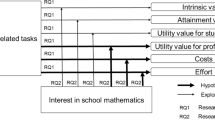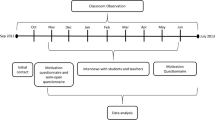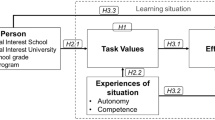Abstract
The lack of students interested in pursuing science, technology, engineering, and mathematics (STEM)-related careers calls for studies that identify variables affecting their career decisions. By drawing on recent conceptualizations of the cost domain first introduced in the expectancy-value theory of achievement motivations, this study investigated whether the perceived difficulty of school science predicted and affected elementary school students (N = 245) task effort and loss of valued alternatives experienced while engaging in a science-related course. Hierarchical multiple regression analysis revealed that students’ perceived difficulty significantly predicted levels of cost experienced when studying science. Likewise, multi-factor ANOVAs revealed that students perceiving school science as a difficult subject reported significantly higher levels of task effort and loss of valued alternatives related to studying science. These findings suggest that the attitudinal dimensions of perceived difficulty play a promising role in the development of cost in science, which has valuable implications for repairing the leaky STEM pipeline.
Similar content being viewed by others
Data Availability
Raw data will be shared on reasonable request to the author of this study.
Notes
The “leaky STEM pipeline” is a metaphor generally used to describe the progressive loss of talent in STEM disciplines. See Cannady et al. (2014) for a discussion about this metaphor.
References
Toma, R. B. (2020). STEM education in elementary grades: Design of an effective framework for improving attitudes towards school science. Ph.D. Dissertation, University of Burgos, Spain.
Toma, R. B., & Greca, I. M. (2018). The effect of integrative STEM instruction on elementary students' attitudes toward science. EURASIA Journal of Mathematics, Science and Technology Education, 14(4), 1383-1395. https://doi.org/10.29333/ejmste/83676
Toma, R. B., & Meneses-Villagrá, J. Á. (2019a). Preferencia por contenidos científicos de física o de biología en Educación Primaria: un análisis clúster [Preference for physics or biology scientific content in Elementary Education: a cluster analysis]. Revista Eureka sobre Enseñanza y Divulgación de las Ciencias, 16(1), 1104. https://doi.org/10.25267/Rev_Eureka_ensen_divulg_cienc.2019.v16.i1.1104p;
Toma, R. B., & Meneses-Villagrá, J. A. (2019). Validation of the single-items Spanish-School Science Attitude Survey (S-SSAS) for elementary education. PLoS ONE, 14(1): e0209027. https://doi.org/10.1371/journal.pone.0209027
Ajzen, I. (1991). The theory of planned behavior. Organizational Behavior and Human Decision Processes, 50(2), 179–211.
Ajzen, I. (2012). Martin fishbein’s legacy: The reasoned action approach. Annals of the American Academy of Political and Social Science, 640(1), 11–27. https://doi.org/10.1177/0002716211423363.
Andersen, L., & Ward, T. J. (2014). Expectancy-value models for the STEM persistence plans of ninth-grade, high-ability students: A comparison between black, hispanic, and white students. Science Education, 98(2), 216–242. https://doi.org/10.1002/sce.21092.
Ardura, D., & Pérez-Bitrián, A. (2018). The effect of motivation on the choice of chemistry in secondary schools: Adaptation and validation of the science motivation questionnaire II to Spanish students. Chemistry Education Research and Practice, 19(3), 905–918. https://doi.org/10.1039/c8rp00098k.
Ball, C., Huang, K. T., Rikard, R. V., & Cotten, S. R. (2017). The emotional costs of computers: An expectancy-value theory analysis of predominantly low-socioeconomic status minority students’ STEM attitudes. Information Communication and Society, 0(0), 1–24. https://doi.org/10.1080/1369118X.2017.1355403
Bøe, M. V. (2012). Science choices in Norwegian upper secondary school: What matters ? Science Education, 96(1), 1–20. https://doi.org/10.1002/sce.20461.
Bybee, R. W. (2013). The case for STEM education. Challenges and opportunities. Arlington, VA: NSTA press.
Cannady, M. A., Greenwald, E., & Harris, K. N. (2014). Problematizing the STEM pipeline metaphor: Is the STEM pipeline metaphor serving our students and the STEM workforce? Science Education, 98(3), 443–460. https://doi.org/10.1002/sce.21108.
Cohen, J. (1988). Statistical power analysis for the behavioral sciences. Hillsdale: Lawrence Erlbaum Associates.
Crawford, B. A. (2014). From inquiry to scientific practices in the science classroom. In N. G. Lederman & S. K. Abell (Eds.), Handbook of research on science education, volume II (pp. 515–541). New York, NY: Routledge.
Cunningham, C. M. (2018). Engineering in elementary STEM education: Curriculum design, instruction, learning, and assessment. New York, NY and Boston, MA: Teachers College Press and Museum of Science Driveway.
DeWitt, J., & Archer, L. (2015). Who aspires to a science career? A comparison of survey responses from primary and secondary school students. International Journal of Science Education, 37(13), 2170–2192. https://doi.org/10.1080/09500693.2015.1071899.
Eccles, J., Adler, T., Futterman, R., Goff, S., Kaczala, C., Meece, J., & Midgley, C. (1983). Expectancies, values, and academic behaviors. In J. Spence (Ed.), Achievement and achievement motivation (pp. 75–146). San Francisco, CA: W. H. Freeman.
Eccles, J. S., & Wigfield, A. (1995). In the mind of the achiever: The structure of adolescents’ academic achievement related-beliefs and self-perceptions. Personality and Social Psychology Bulletin, 21, 215–225.
Flake, J. K., Barron, K. E., Hulleman, C., McCoach, B. D., & Welsh, M. E. (2015). Measuring cost: The forgotten component of expectancy-value theory. Contemporary Educational Psychology, 41, 232–244. https://doi.org/10.1016/j.cedpsych.2015.03.002.
Gago, J. M, Ziman, J., Caro, P., Constantinou, C. P., Davies, G., Parchmann, I., Rannikmae, M. and Sjøberg, S. (2014). Increasing human resources for science and technology in Europe: Report of the high level group on human resources for science and technology in Europe. European Commision, DG Research, Science and Society Programme.
Guo, J., Marsh, H. W., Parker, P. D., Morin, A. J. S., & Dicke, T. (2017). Extending expectancy-value theory predictions of achievement and aspirations in science: Dimensional comparison processes and expectancy-by-value interactions. Learning and Instruction, 49, 81–91. https://doi.org/10.1016/j.learninstruc.2016.12.007.
Guo, J., Marsh, H. W., Parker, P. D., Morin, A. J. S., & Yeung, A. S. (2015a). Expectancy-value, gender and socioeconomic background as predictors of achievement and aspiration: A multi-cohort study. Learning and Individual Differences, 37, 161–168. https://doi.org/10.1016/j.lindif.2015.01.008.
Guo, J., Parker, P. D., Marsh, H. W., & Morin, A. J. S. (2015b). Achievement, motivation, and educational choices: A longitudinal study of expectancy and value using a multiplicative perspective. Developmental Psychology, 51(8), 1163–1176. https://doi.org/10.1037/a0039440.
Kennedy, J., Lyons, T., & Quinn, F. (2014). The continuing decline os science and mathematics enrolments in Australian high schools. Teaching Science, 60(2), 34–46.
Kennedy, J., Quinn, F., & Taylor, N. (2016). The school science attitude survey: A new instrument for measuring attitudes towards school science. International Journal of Research & Method in Education, 39(4), 422–445. https://doi.org/10.1080/1743727X.2016.1160046.
Kline, P. (2000). The handbook of psychological testing. New York: Routledge.
Knapp, H. (2018). Intermediate statistics using SPSS. Thousand Oaks, California: Sage Publications, Inc..
Kosovich, J. J., Hulleman, C. S., Barron, K. E., & Getty, S. (2015). A practical measure of student motivation: Establishing validity evidence for the expectancy-value-cost scale in middle school. Journal of Early Adolescence, 35(5–6), 790–816. https://doi.org/10.1177/0272431614556890.
LOMCE. (2013). Ley Orgánica 8/2013, de 9 de diciembre, para la mejora de la calidad educativa.
Luttrell, V. R., Callen, B. W., Allen, C. S., Wood, M. D., Deeds, D. G., & Richard, D. C. S. (2010). The mathematics value inventory for general education students: Development and initial validation. Educational and Psychological Measurement, 70(1), 142–160. https://doi.org/10.1177/0013164409344526.
Lykkegaard, E., & Ulriksen, L. (2016). Choices and changes: Eccles’ expectancy-value model and upper-secondary school students’ longitudinal reflections about their choice of a STEM education. International Journal of Science Education, 38(5), 701–724. https://doi.org/10.1080/09500693.2016.1156782.
Maltese, A. V., & Tai, R. H. (2011). Pipeline persistence: Examining the association of educational experiences with earned degrees in STEM among U.S. students. Science Education, 95(5), 877–907. https://doi.org/10.1002/sce.20441.
MECD. (2016a). Datos y cifras del sistema universitario español. Curso 2015/2016 [Facts and figures on the Spanish university system. Academic year 2015/2016]. Madrid: Secretaría general Técnica.
MECD. (2016b). TIMSS 2015. Estudio internacional de tendencias en Matemáticas y Ciencias. Informe Español: Resultados y Contexto [TIMSS 2015. International Study of Trends in Mathematics and Science. Spanish Report: Results and Context]. Madrid: Secretaría general Técnica.
MECD. (2019). PISA 2018. Programa para la evaluación internacional de los estudiantes: Informe Español [PISA 2018. Program for the international evaluation of students: Spanish report]. Madrid: Secretaría General Técnica.
MEFP. (2019). Panorama de la educación: Indicadores de la OCDE 2019. Informe español [Education at a Glance: OECD Indicators 2019. Spanish report]. Madrid: Secretaría General Técnica.
Montes, L. H., Ferreira, R. A., & Rodríguez, C. (2018). Explaining secondary school student’s attitudes towards chemistry in Chile. Chemistry Education Research and Practice, 19(2), 533–542. https://doi.org/10.1039/c8rp00003d.
OECD. (2016). PISA 2015 results (volume II): Policies and practices for successful schools. Paris: OECD Publishing.
Osborne, J., Simon, S., & Collins, S. (2003). Attitudes towards science: A review of the literature and its implications. International Journal of Science Education, 25(9), 1049–1079. https://doi.org/10.1080/0950069032000032199.
Perez, T., Cromley, J. G., & Kaplan, A. (2014). The role of identity development, values, and costs in college STEM retention. journal of Educational Psychology, 106(1), 315–329. doi:https://doi.org/10.1037/a0034027.
Tai, R. H. ., Liu, C. Q., Maltese, A. V. ., & Fan, X. (2006). Planning early for careers in science. Science, 312(5777), 1143–1144. https://doi.org/10.1126/science.1128690.
Riegle-Crumb, C., Moore, C., & Ramon-Wada, A. (2011). Who wants to have a career in science or math? Exploring adolescents’ future aspirations by gender and race/ethnicity. Science Education, 95(3), 458–476. https://doi.org/10.1002/sce.20431.
Ryan, R. M., & Deci, E. L. (2000). Self-determination theory and the facilitation of intrinsic motivation, social development, and well-being.American psychologist, 55(1), 68–78. https://doi.org/10.1037/110003-066X.55.1.68
Wigfield, A., & Eccles, J. S. (2002). The development of competence beliefs, expectacies for success, and achievement values from childhood through adolescence. In A. Wigfield & J. S. Eccles (Eds.), Development of achievement motivation (pp. 91–120). San Diego: Academic Press.
Trafimow, D., Sheeran, P., Conner, M., & Finlay, K. (2002). Evidence that perceived behavioural control is a multidimensional construct: Perceived control and perceived difficulty. British Journal of Social Psychology, 41(1), 101–121. https://doi.org/10.1348/014466602165081.
Wigfield, A., & Cambria, J. (2010). Students’ achievement values, goal orientations, and interest: Definitions, development, and relations to achievement outcomes. Developmental Review, 30(4), 1–35. https://doi.org/10.1016/j.dr.2009.12.001.
Wigfield, A., & Cambria, J. (2014). Expectancy-value theory: Retrospective and prospective. In T. C. Urdan & S. A. Karabenick (Eds.), The decade ahead: theoretical perspectives on motivation and achievement (advances in motivation and achievement, Volume 16 Part A) (pp. 35–70). Emerald Group Publishing Limited.
Wigfield, A., & Eccles, J. S. (2000). Expectancy-value theory of motivation. Contemporary Educational Psychology, 25, 68–81.
Funding
This investigation was conducted under the Ph.D. research fellowship Resolución de 19 de mayo de 2017 del Vicerrector de Investigación y Transferencia del Conocimiento para financiar contratos predoctorales de la Universidad de Burgos [Resolution of 19 May 2017 of the Vice-Rector for Research and Knowledge Transfer to finance Ph.D. research fellowships at the University of Burgos], granted to the author of this study.
Author information
Authors and Affiliations
Corresponding author
Ethics declarations
Conflict of Interest
The author declares that he has no conflict of interest.
Ethical Approval
All procedures performed in studies involving human participants were approved by the Vice-rectorate of Research and the Doctorate Program of the University of Burgos. All study participants provided informed consent signed by their parents or their legally authorized representatives.
Additional information
Publisher’s Note
Springer Nature remains neutral with regard to jurisdictional claims in published maps and institutional affiliations.
Rights and permissions
About this article
Cite this article
Toma, R.B. Perceived Difficulty of School Science and Cost Appraisals: a Valuable Relationship for the STEM Pipeline?. Res Sci Educ 52, 553–565 (2022). https://doi.org/10.1007/s11165-020-09963-5
Accepted:
Published:
Issue Date:
DOI: https://doi.org/10.1007/s11165-020-09963-5




